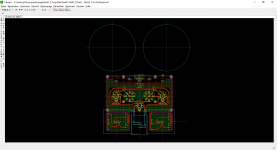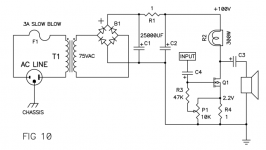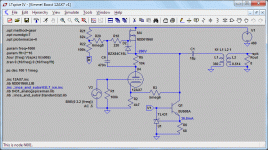Like he saidI agree with Shoog, the CCS in an SE is somewhat trendy nonsense, a simple R+C gives rather that nice soft clipping sound.
The LED array would be same as a zener, which potentially could make a benefit of keeping the bottle a little bit cooler, but you gotta carefully audition it and pick a precisely right one (not overdo).
I am wondering how a choke would do instead of R+C.

Shoog
So, my ideas are on a new thread, for anyone interested. I don't want to further clutter the OP's thread with my ramblings 😉
The Champion SE amplifier.
Give it a look 😎
No worry - the OP hasn't been seen anywhere on this site for over a week. As often happens, nobody notices and the thread takes on a life of its own.
i am clueless as how a SE El84 / SE 6sn7 can be of any use to anybody.
I strongly believe it would sound worst than a 15 $ transistor amplifier
It is very easy to build one and find out why there are so many who like them. If you have not listened or made on for your own amusement or edification then you can only wonder.
A CCS has especially no place in a minimalist circuit, since it requires at least one additional active element, which is put to better use somewhere else. See #52 for my minimalist design using only two triodes.Also a CCS has no place in such a design or any other SE design for that matter.
I believe anything less, i.e. only one active element, does not classify as hi-fi.
I like the circuit from Frank Blöhbaum (german):
PP-Verstaerker nur mit Eisen, Draht und Roehre von Frank Bloehbaum
PCB in process, breaning on attenuator (Silvercore solution isn´t cheap) and supplies (Pete millett´s DC/DC converter with Würth Flyback transformer).
Output transformer from Toroidy.
JP
PP-Verstaerker nur mit Eisen, Draht und Roehre von Frank Bloehbaum
PCB in process, breaning on attenuator (Silvercore solution isn´t cheap) and supplies (Pete millett´s DC/DC converter with Würth Flyback transformer).
Output transformer from Toroidy.
JP
Attachments
A CCS has especially no place in a minimalist circuit, since it requires at least one additional active element, which is put to better use somewhere else. See #52 for my minimalist design using only two triodes.
I believe anything less, i.e. only one active element, does not classify as hi-fi.
There is one place in which a CCS has a role in an SE and that is in a parafeed plate load.
I have to disagree with your other point as I can attest that a single E55L make a very high performance 3w amp.
Shoog
A CCS has especially no place in a minimalist circuit, since it requires at least one additional active element, which is put to better use somewhere else. See #52 for my minimalist design using only two triodes.
I believe anything less, i.e. only one active element, does not classify as hi-fi.
Eh, maybe... Even an EL84 makes a decent spud with an input transformer if your signal is hot enough, as do some of the subminiature tubes, depending on desired power. If one watt or so will drive the intended speakers you would be surprised at the options for a nice low THD single tube solution.
There is one place in which a CCS has a role in an SE and that is in a parafeed plate load.
I have to disagree with your other point as I can attest that a single E55L make a very high performance 3w amp.
Shoog
Agreed, although a plate load CCS can be useful for a driver tube too, depending on what your goals are.
In that topology, the CCS plate load essentially becomes the output stage, delivering all the power. The tube effectively drives the CCS "from the bottom".There is one place in which a CCS has a role in an SE and that is in a parafeed plate load.
I don't like it, and it's no minimalist.
I looked at you "ultimate" design, and it's of the topology above.I have to disagree with your other point as I can attest that a single E55L make a very high performance 3w amp.
Problems with single triode (pentode, whatever) spud amps is tube tolerances and Zout, which means channel imbalance and boomy single note bass. Certainly not hifi.
The Delite by Nelson Pass (link to pdf) arguably has one active element: an Nchannel MOSFET. Arguably it classifies as hi-fi based on the good measured results and many very pleased builders and listeners. It's a single ended common source amplifier using a resistor load. The resistor is a 300 watt light bulb.I believe anything less, i.e. only one active element, does not classify as hi-fi.
_
Attachments
Yeah, but it's not really a tube amp, eh?The Delite by Nelson Pass (link to pdf) arguably has one active element: an Nchannel MOSFET.
I have to disagree, the output tube is definitely the dominant sonic component since its impedance is always lower and in parallel with the plate load. Parallel loads always tend to the lowest impedance component - ie the valve not the CCS.In that topology, the CCS plate load essentially becomes the output stage, delivering all the power. The tube effectively drives the CCS "from the bottom".
I don't like it, and it's no minimalist.
This applies to just about any of the many zero feedback SE designs out there. Couple them to the right sort of high Q OB speakers and they work just fine. Try to drive a standard sealed box with them and you will get the results you imply - but that applies to just about all SE amps. If you want what SE has to offer then a spud can deliver all the best aspects of SE in spades.I looked at you "ultimate" design, and it's of the topology above.
Problems with single triode (pentode, whatever) spud amps is tube tolerances and Zout, which means channel imbalance and boomy single note bass. Certainly not hifi.
If you are implying that only a feedback dominated amplifier can deliver HIFI - then I am just going to have to disagree with you.
Having said that, I would always tend to prefer a PP amplifier over an SE one, and always local feedback over global. Still I have that E55L amp in daily service and it performs very well with my OB three ways speakers.
Shoog
Last edited:
No disagreement here. The tube defines the transfer function. However, all the power drive will be provided by the CCS. See attached example.I have to disagree, the output tube is definitely the dominant sonic component since its impedance is always lower and in parallel with the plate load. Parallel loads always tend to the lowest impedance component - ie the valve not the CCS.
~3W from a single measly 12ax7. How can that be?
It's a hybrid topology.
I'm not. But the the high gm thoroughbred tubes proposed for spuds exhibit much more sample to sample variation than quality audio finals used for more traditional SE amps. Some nfb is a proper measure to tame these.If you are implying that only a feedback dominated amplifier can deliver HIFI - then I am just going to have to disagree with you.
Attachments
No disagreement here. The tube defines the transfer function. However, all the power drive will be provided by the CCS. See attached example.
~3W from a single measly 12ax7. How can that be?
It's a hybrid topology.
I
What you posted is not a CCS loaded valve amp - the cathode circuit effectively bypasses the valve. In a CCS loaded valve SE the whole current must pass through the valve which contributes almost all of the sonic profile of the amplifier.
Your not really comparing apples with apples.
I'm not. But the the high gm thoroughbred tubes proposed for spuds exhibit much more sample to sample variation than quality audio finals used for more traditional SE amps. Some nfb is a proper measure to tame these.
As for this, its just about the same as almost all SE amplifiers - so your point is - SE amplifiers are fundamentally flawed, well I must agree.
However my experience with premium valves, such as the E55L, doesn't really back up the claim that this is a major issue to deal with.
Shoog
That's just pointless quibbling. If the top CCS isn't loading the tube, what else is?What you posted is not a CCS loaded valve amp - the cathode circuit effectively bypasses the valve. In a CCS loaded valve SE the whole current must pass through the valve which contributes almost all of the sonic profile of the amplifier.
The bottom CCS just pulls more current thru the top, boosting the available class A power.
The CCSes provide all the output power, the 12ax7 provides the voltage amplification.
This topology is just a cleverly arranged hybrid amp with a disguised tube VAS and a sand output stage. The fact that you are able to remove the bottom CCS for less output power does not change its fundamental operation.
Cool design! what if we were to use an ECL86 for a little more power out? Probably use a Hammond 125DSE instead of the CSE? Anything else?To do the same thing but without the transistor, perhaps like this ?
Mona
Sent from my phone. Please excuse any typpos.
Totally agree.reasonably well-done push-pull EL84 amp can't help but sound nice.
For example, the Red Light District is a great EL84 design that's quite straight forward, and is fun because of all the LEDs 🙂
Sent from my phone. Please excuse any typpos.
I theme to think you'll get better sparkle and 'air' of you increase your voltages. EL84s run happily at around 330V+ on the anode, with 300 on the screen, and sound really good!Just finished a triode EL84 amplifier which runs quite low voltage and can be build for around $1000 canadian,
It has the 'beautiful' tube sound that people want, with high distortions, however the sound is quite good even compared to the best amplifiers, distortion is 0.3% at 1Watt, 0.72% at 2 Watts and 10.4 % at 4 watts (all RMS watts of course!)
Transformer is triode 10 watts, bass is not well defined but all there due to extra harmonics, high frequencies are poor, there is no sparkles of the top end, 'air' is average, instrument separation poor.
this is with 87db speakers, it could be a different story with 95+ speaker.
Sent from my phone. Please excuse any typpos.
+1
Also, give it a bit of negative feedback to bring out the bass and clean up the high end, dropping the distortion, and improve damping factor. Then, throw it in pentode mode, and I think you will be pleased with the result.
Also, give it a bit of negative feedback to bring out the bass and clean up the high end, dropping the distortion, and improve damping factor. Then, throw it in pentode mode, and I think you will be pleased with the result.
I theme to think you'll get better sparkle and 'air' of you increase your voltages. EL84s run happily at around 330V+ on the anode, with 300 on the screen, and sound really good!
Sent from my phone. Please excuse any typpos.
Thanks, I will raise the voltage, easy because I used 5y3 rectifier, and capacitors can take 500V, including input stage,
I will raise the value of cathode resistor to around 300 and raise voltagewith 5ar4
and report on the 'air' ! thanks,
- Status
- Not open for further replies.
- Home
- Amplifiers
- Tubes / Valves
- Best "minimal" amplifier circuit


